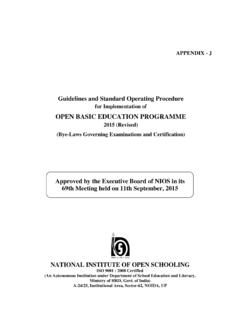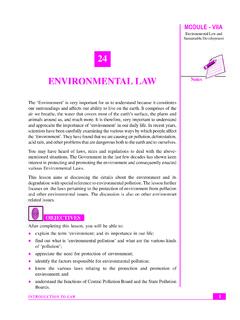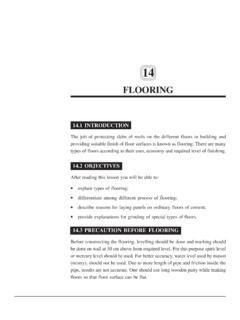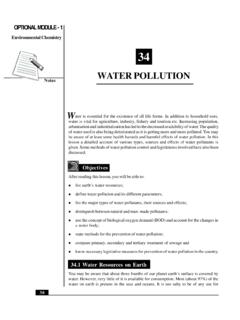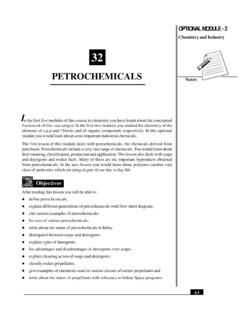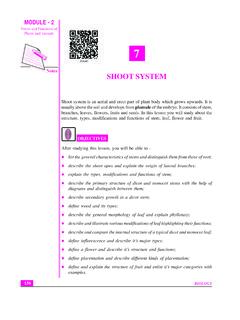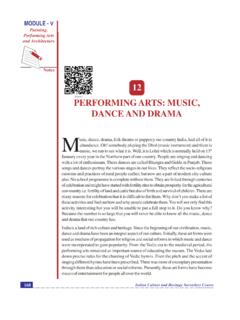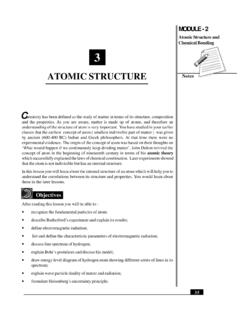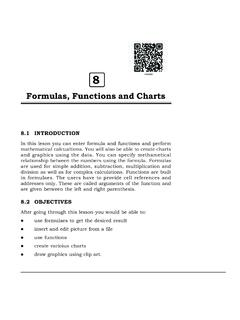Transcription of 14 SCIENCE AND TECHNOLOGY IN INDIA L
1 SCIENCE and TECHNOLOGY in IndiaNotesIndian Culture and Heritage Secondary Course 214 MODULE - VIScience andTechnology14 SCIENCE AND TECHNOLOGYIN INDIALike people in any other part of the world Indians too, have a rich legacy of scientificideas. A desire to now the unknown, accompanied with experimentation andobservation have always generated scientific temper. This has led to the assumptionthat truth lay in the real world with all its diversity and complexity. It has been theresponsibility of scientists to unravel the mystery behind the truth and utilise availableresources for the progress of humanity.
2 1n the following pages you will be reading aboutthis continuous search for knowledge and truth leading to discoveries and inventions andtheir application in day-to-day life in INDIA . OBJECTIVESA fter reading this lesson you will be able to: identify the development of SCIENCE in INDIA ; recognise the various scientific fields in which Indians have made theircontributions; examine the various forces and factors that help in developing SCIENCE duringany period; and draw linkages between modern Indian SCIENCE and its rich scientific heritage.
3 DEVELOPMENT OF SCIENCE IN ANCIENT INDIAM athematics has been called by the general name of Ganita which includes Arithmetic s,Geometry, Algebra, Astronomy and Astrology. Arithmetic is called by several names suchScience and TECHNOLOGY in IndiaNotes 215 Indian Culture and Heritage Secondary CourseMODULE - VIScience andTechnologyas Pattin Ganita (calculations on board), Anka Ganita (calculations with numerals). Geometryis called Rekha Ganita (line works) and Algebra, Bija Ganita (seed analysis), Astronomyand Astrology are included in the term has a rich heritage of SCIENCE and TECHNOLOGY .
4 The dependence on nature could beovercome by developments in SCIENCE . In ancient INDIA , religion and SCIENCE worked inclose proximity. Let us find out about the developments in the different branches of sciencein the ancient made great progress. The movement of planets came to be emphasized andclosely observed. Jyotishvedanga texts established systematic categories in astronomybut the more basic problem was handled by Aryabhatta (499 AD). His Aryabhattiya is aconcise text containing 121 verses. It contains separate sections on astronomical definitions,methods of determining the true position of the planets, description of the movement of thesun and the moon and the calculation of the eclipses.
5 The reason he gave for eclipse wasthat the earth was a sphere and rotated on its axis and when the shadow of the earth fell onthe moon, it caused Lunar eclipse and when the shadow of the moon fell on the earth, itcaused Solar eclipse. On the contrary, the orthodox theory explained it as a processwhere the demon swallowed the planet. All these observations have been described byVarahamihira in Panch Siddhantika which gives the summary of five schools of astronomypresent in his time. Aryabhatta deviated from Vedic astronomy and gave it a scientificoutlook which became a guideline for later astronomers.
6 Astrology and horoscope werestudied in ancient INDIA . Aryabhatta s theories showed a distinct departure from astrologywhich stressed more on beliefs than scientific town planning of Harappa shows that the people possessed a good knowledge ofmeasurement and geometry. By third century AD mathematics developed as a separatestream of study. Indian mathematics is supposed to have originated from the in second century BC, introduced practical geometry involving acute angle,obtuse angle and right angle. This knowledge helped in the construction of fire altars wherethe kings offered sacrifices.
7 The three main contributions in the field of mathematics werethe notation system, the decimal system and the use of zero. The notations and the numeralswere carried to the West by the Arabs. These numerals replaced the Roman was discovered in INDIA in the second century BC. Brahmagupta s BrahmasputaSiddhanta is the very first book that mentioned zero as a number, hence, Brahmagupta isconsidered as the man who found zero. He gave rules of using zero with other discovered algebra and also formulated the area of a triangle, which led to theorigin of and TECHNOLOGY in IndiaNotesIndian Culture and Heritage Secondary Course 216 MODULE - VIScience andTechnologyThe Surya Siddhanta is a very famous work.
8 Varahamihira s Brihatsamhita of the sixthcentury AD is another pioneering work in the field of astronomy. His observation that themoon rotated around the earth and the earth rotated around the sun found recognition andlater discoveries were based on this assertion. Mathematics and astronomy together ignitedinterest in time and cosmology. These discoveries in astronomy and mathematics becamethe cornerstones for further research and , cure and medicines were mentioned for the first time in the Atharva Veda. Fever,cough, consumption, diarrhoea, dropsy, sores, leprosy and seizure are the diseasesmentioned.
9 The diseases are said to be caused by the demons and spirits entering one sbody. The remedies recommended were replete with magical charms and 600 BC began the period of rational sciences. Takshila and Taranasi emerged ascentres of medicine and learning. The two important texts in this field are Charaksamhitaby Charak and Sushrutsamhita by Sushruta. How important was their work can beunderstood from the knowledge that it reached as far as China, Central Asia throughtranslations in various plants and herbs used for medicinal purposes have been mentioned in came to be mentioned as a separate stream around fourth century AD.
10 Sushrutawas a pioneer of this discipline. He considered surgery as the highest division of thehealing arts and least liable to fallacy . He mentions 121 surgical instruments. Along withthis he also mentions the methods of operations, bone setting, cataract and so on. Thesurgeons in ancient INDIA were familiar with plastic surgery (repair of noses, ears and lips).Sushruta mentions 760 plants. All parts of the plant roots, barks, flowers, leaves etc. wereused. Stress was laid on diet ( salt free diet for nephrites).
